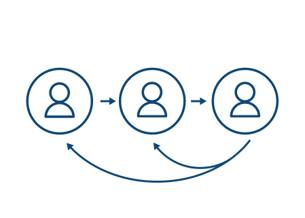Access DOJ: DOJ's Customer Experience Office
Making DOJ's services easy, effective, and efficient for all Americans.
Millions of people interact with DOJ every day through our mission to uphold the rule of law, keep our country safe, and protect civil rights. Simplifying access to our programs, services and resources will enhance our ability to deliver on this mission.
Who We Are
Access DOJ, DOJ's Customer Experience Office, is led by the Office for Access to Justice and works to make DOJ’s services:
- Easy – Ensure our information is easy for everyone to find, understand, and use.
- Effective – Address the needs and expectations of the communities we serve.
- Efficient – Streamline resources and save taxpayer dollars.
Our Approach
Human-centered design (HCD) is a people-centered problem-solving process used to develop solutions that address people’s needs. Scholars, experts, and practitioners are increasingly exploring how CX can help agencies serve the public more effectively.

Here's how it works:
- Learn – Review existing research and understand customer needs.
- Create – Identify and shape solutions to help DOJ better meet those needs.
- Evaluate – Test the solution to ensure it is easy, effective, and efficient.
What this looks like in practice:
- Usability Testing – Getting feedback from people who use DOJ’s forms, websites, and services to identify opportunities for improvement.
- Researching Best Practices – Identifying and incorporating proven approaches.
- Listening Sessions – Engaging with the public to inform efforts.
- Analyzing data – Reviewing data on public engagement and interaction to expand access to public-facing information.
What We Do
Access DOJ collaborates with DOJ components to make their programs, resources, and services easy, effective, and efficient. We do so through three main areas of work:
High-Impact Projects: We annually conduct high-impact projects in partnership with Justice Department components, providing intensive planning, research and design support.
Resources and Technical Support: We deliver hands-on coaching and support in methods like usability testing and plain language. We also promote the development of human-centered design knowledge and skills through Access DOJ’s resources and trainings.
Community of Practice: We chair a community of practice with representatives from across the Department to improve services through design, share successes and challenges, and identify solutions to advance this work together.
Case Studies
Here’s how we're making DOJ services easy, effective, and efficient.

In collaboration with Office of the Pardon Attorney (PARDON)

In collaboration with the U.S. Trustee Program (USTP)
Sign Up for Initiative Updates
Subscribe to our quarterly Access DOJ newsletter to stay updated on our work.

 U.S. Department
of Justice
U.S. Department
of Justice